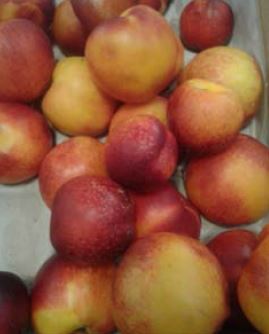Nectarines for birds (with Info Table & video)
Nectarines are good for birds. It is also known as Peach.

Info table about nectarines:
| Name: |
| Nectarine |
| Scientific name: |
| Prunus persica |
| Also known as: |
| Peach |
| Indigenous Countries: |
| Native to the region of Northwest China between the Tarim Basin and the north slopes of the Kunlun Mountains. |
| Can be given to: |
| Parrots, budgies, parakeets, finches, cockatiels, lovebirds, canaries, and conures. |
| Description: |
| Peaches and nectarines are the same species, even though they are regarded commercially as different fruits. |
| Nutritional Value: |
| Rich in vitamins and minerals. |
| Feeding: |
| Remove pits. Give in moderation because of the high sugar content. |
| Discussion: |
| High sugar content. |
| Featured photo courtesy: |
| Petrus van Tonder |
How to feed nectarines to birds:
Remove the pits and feed in moderation. The pips contain a cyanide-like substance that can be fatal for your beautiful bird.
About fruit from Tony Silva:
Cultivated fruits have been selected to suit the human palette, which with each generation requires sweeter fruit. The results of this mean that many cultivated varieties of apple available today have as much as 160 grams of sugar per kilogram of fruit. Just 50 years ago, the sugar content was less than half. The same can be stated for grapes, pears, peaches, oranges, etc. If you examine wild fruit eaten by parrots, few are rich in sugar, and very rarely are they eaten when the sugar content is at its peak. Indeed, as previously stated, fruits are preferred when they are not ripe. As an example, in Seville, Spain, I have seen feral Ring-necked Parakeets Psittaculakramerifeed on the most bitter oranges imaginable, even though a sweet tangerine tree was growing nearby.
Cultivated fruit can be included in the diet but select varieties that are not packages of sugar. This means seeking out some of the heirloom varieties or picking types intended for cooking. Tropical fruits are excellent. Many have high sugar contents but they are nutritionally superior to temperature fruit and this in my opinion justifies their use. Mango,genip, papaya, guava, Opuntia cactus fruit, carambola, etc are all suitable. The list is long and again can vary from region to region.
Video about fruit:
You might also be interested in ginger for your birds:
https://www.wwbirds.co.za/dir/can-birds-eat-ginger/
101 Food Items for Birds eBook
Much more feeding tips are available in our eBook, 101 Food Items for Birds. Click on cover for more information:

Follow me on Instagram to find an A to Z list of feeding tips:



